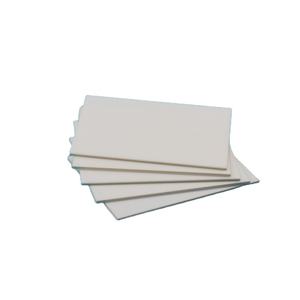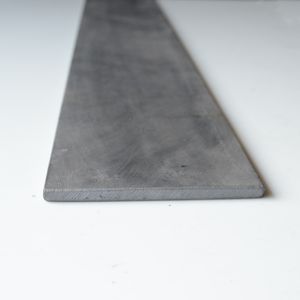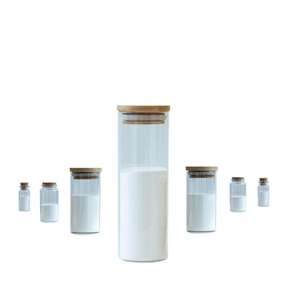Intro to Aluminum Nitride Ceramics
Light weight aluminum nitride (AlN) is a high-performance ceramic product that has obtained prevalent acknowledgment for its remarkable thermal conductivity, electrical insulation, and mechanical stability at raised temperatures. With a hexagonal wurtzite crystal structure, AlN exhibits a special combination of residential properties that make it the most ideal substratum product for applications in electronics, optoelectronics, power modules, and high-temperature settings. Its capability to efficiently dissipate warmth while preserving exceptional dielectric toughness positions AlN as a superior option to typical ceramic substratums such as alumina and beryllium oxide. This short article explores the essential features of light weight aluminum nitride ceramics, explores fabrication strategies, and highlights its vital duties throughout advanced technological domain names.
(Aluminum Nitride Ceramics)
Crystal Structure and Essential Quality
The efficiency of light weight aluminum nitride as a substrate material is mainly determined by its crystalline structure and innate physical homes. AlN takes on a wurtzite-type lattice composed of alternating light weight aluminum and nitrogen atoms, which adds to its high thermal conductivity– usually surpassing 180 W/(m · K), with some high-purity samples accomplishing over 320 W/(m · K). This value substantially surpasses those of other extensively used ceramic materials, including alumina (~ 24 W/(m · K) )and silicon carbide (~ 90 W/(m · K)).
In addition to its thermal performance, AlN possesses a wide bandgap of about 6.2 eV, resulting in superb electric insulation residential or commercial properties even at high temperatures. It also shows low thermal expansion (CTE ≈ 4.5 × 10 ⁻⁶/ K), which carefully matches that of silicon and gallium arsenide, making it an ideal suit for semiconductor device product packaging. Moreover, AlN shows high chemical inertness and resistance to thaw metals, improving its viability for extreme settings. These consolidated attributes establish AlN as a leading candidate for high-power digital substrates and thermally managed systems.
Fabrication and Sintering Technologies
Producing top notch aluminum nitride porcelains calls for exact powder synthesis and sintering techniques to attain thick microstructures with very little contaminations. As a result of its covalent bonding nature, AlN does not quickly compress with traditional pressureless sintering. For that reason, sintering help such as yttrium oxide (Y TWO O ₃), calcium oxide (CaO), or uncommon earth aspects are typically contributed to promote liquid-phase sintering and enhance grain limit diffusion.
The manufacture procedure normally begins with the carbothermal reduction of light weight aluminum oxide in a nitrogen environment to manufacture AlN powders. These powders are after that crushed, shaped through approaches like tape spreading or injection molding, and sintered at temperatures between 1700 ° C and 1900 ° C under a nitrogen-rich ambience. Hot pressing or spark plasma sintering (SPS) can further enhance thickness and thermal conductivity by minimizing porosity and promoting grain positioning. Advanced additive manufacturing strategies are likewise being checked out to fabricate complex-shaped AlN parts with customized thermal management capabilities.
Application in Digital Product Packaging and Power Modules
Among the most noticeable uses light weight aluminum nitride ceramics remains in digital packaging, especially for high-power devices such as protected entrance bipolar transistors (IGBTs), laser diodes, and radio frequency (RF) amplifiers. As power densities boost in modern electronic devices, efficient heat dissipation comes to be critical to make sure dependability and long life. AlN substratums provide an optimal service by combining high thermal conductivity with exceptional electric isolation, protecting against short circuits and thermal runaway conditions.
In addition, AlN-based direct adhered copper (DBC) and energetic metal brazed (AMB) substrates are increasingly employed in power component layouts for electric cars, renewable resource inverters, and commercial electric motor drives. Contrasted to traditional alumina or silicon nitride substrates, AlN supplies quicker warmth transfer and better compatibility with silicon chip coefficients of thermal development, thereby reducing mechanical stress and improving overall system efficiency. Continuous research study aims to enhance the bonding strength and metallization strategies on AlN surface areas to further broaden its application extent.
Use in Optoelectronic and High-Temperature Instruments
Beyond electronic product packaging, aluminum nitride ceramics play an essential role in optoelectronic and high-temperature applications as a result of their openness to ultraviolet (UV) radiation and thermal stability. AlN is widely used as a substratum for deep UV light-emitting diodes (LEDs) and laser diodes, particularly in applications requiring sanitation, picking up, and optical interaction. Its large bandgap and reduced absorption coefficient in the UV array make it a perfect prospect for supporting aluminum gallium nitride (AlGaN)-based heterostructures.
Furthermore, AlN’s ability to work reliably at temperature levels surpassing 1000 ° C makes it suitable for use in sensors, thermoelectric generators, and components exposed to severe thermal tons. In aerospace and protection fields, AlN-based sensor packages are utilized in jet engine surveillance systems and high-temperature control systems where traditional materials would certainly fail. Constant improvements in thin-film deposition and epitaxial development techniques are broadening the possibility of AlN in next-generation optoelectronic and high-temperature integrated systems.
( Aluminum Nitride Ceramics)
Environmental Security and Long-Term Dependability
A key consideration for any substrate material is its long-term reliability under functional anxieties. Light weight aluminum nitride shows superior environmental stability compared to several other ceramics. It is extremely immune to rust from acids, antacid, and molten metals, making sure durability in aggressive chemical settings. Nonetheless, AlN is susceptible to hydrolysis when subjected to wetness at elevated temperatures, which can weaken its surface and minimize thermal efficiency.
To minimize this issue, safety layers such as silicon nitride (Si ₃ N FOUR), aluminum oxide, or polymer-based encapsulation layers are frequently related to improve wetness resistance. Furthermore, mindful securing and product packaging approaches are executed throughout tool assembly to maintain the integrity of AlN substrates throughout their life span. As environmental guidelines end up being much more strict, the safe nature of AlN likewise places it as a preferred choice to beryllium oxide, which postures health risks during handling and disposal.
Verdict
Aluminum nitride ceramics represent a class of advanced materials distinctly matched to resolve the expanding needs for reliable thermal monitoring and electric insulation in high-performance electronic and optoelectronic systems. Their extraordinary thermal conductivity, chemical stability, and compatibility with semiconductor modern technologies make them one of the most ideal substrate product for a wide variety of applications– from automotive power modules to deep UV LEDs and high-temperature sensing units. As fabrication modern technologies continue to progress and affordable manufacturing approaches grow, the fostering of AlN substratums is expected to rise considerably, driving development in next-generation electronic and photonic gadgets.
Distributor
Advanced Ceramics founded on October 17, 2012, is a high-tech enterprise committed to the research and development, production, processing, sales and technical services of ceramic relative materials and products. Our products includes but not limited to Boron Carbide Ceramic Products, Boron Nitride Ceramic Products, Silicon Carbide Ceramic Products, Silicon Nitride Ceramic Products, Zirconium Dioxide Ceramic Products, etc. If you are interested, please feel free to contact us.(nanotrun@yahoo.com)
Tags: aluminum nitride ceramic, aln aluminium nitride, aln aluminum nitride ceramic
All articles and pictures are from the Internet. If there are any copyright issues, please contact us in time to delete.
Inquiry us







